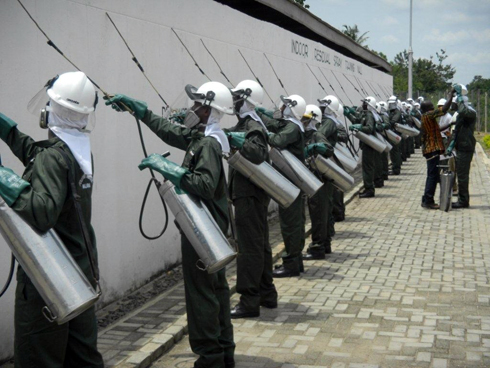A 75% reduction in reported malaria cases over four years in a gold mining community. Consistent achievement of indoor residual spraying targets. Strong partnerships with the Ministry of Health, local government, the environment sector and community leaders. These are some of the outcomes of a public-private partnership to prevent and control malaria in Obuasi, Ghana, led by AngloGold Ashanti (AGA), the third-largest gold mining company in the world.
 Hailed as a “a huge success” by the Global Fund to Fight AIDS, Tuberculosis and Malaria (Global Fund), AGA’s programme is featured as a case study in TDR’s new guidance framework on a “Multisectoral approach to the prevention and control of vector-borne diseases” . The document, published today, aims to provide practical support to decision-makers to design comprehensive strategies involving multiple sectors for the prevention and control of vector-borne diseases (VBDs).
Hailed as a “a huge success” by the Global Fund to Fight AIDS, Tuberculosis and Malaria (Global Fund), AGA’s programme is featured as a case study in TDR’s new guidance framework on a “Multisectoral approach to the prevention and control of vector-borne diseases” . The document, published today, aims to provide practical support to decision-makers to design comprehensive strategies involving multiple sectors for the prevention and control of vector-borne diseases (VBDs).
It is increasingly recognized that the prevention and control of many diseases, including VBDs, must be driven by more than just the health sector alone and that a multisectoral approach is required. The 2030 Agenda for Sustainable Development offers a great opportunity to bring together different sectors, such as water and sanitation, agriculture and education, by providing a common language to stakeholders.
The development of the guidance framework is based on a landscape analysis of multisectoral approaches through six commissioned reviews and the organization of a workshop to discuss the research priorities. The Swiss Agency for Development and Cooperation, the Canadian International Development and Research Centre and the Swiss Tropical and Public Health Institute supported the commissioned reviews and the workshop, which resulted in a recommendation to develop the guidance document.
The AGA case study is presented as a successful public–private partnership that began in Obuasi Municipal District in 2005. The programme included integrated malaria control interventions such as indoor residual spraying, targeted larviciding, community lifestyle change, prompt and effective case detection and management, as well as distribution of insecticide-treated nets to targeted groups.
 Photo credit: AngloGold Ashanti Photo credit: AngloGold Ashanti | AGA has worked closely with relevant public institutions, namely the Ghana Health Service, the Environmental Protection Agency, Ministry of Local Government, and other third parties, including the Global Fund. The Ministry of Health provided policy direction and ensured that the project aligns with the national malaria programme objectives. AGA’s programme achieved a 75% reduction in reported malaria cases by December 2009 at the main hospital for the Obuasi Mine (Edwin Cade Hospital). AGA has since implemented similar programmes at their Siguiri Mine in Guinea and Geita Mine in Tanzania. |
“To accelerate progress towards tackling vector-borne diseases, we must break the silos and work together,” said TDR Director, John Reeder. “It is our hope that this guidance will create that momentum, and we encourage policy-makers, programme implementers and researchers to pursue multisectoral approaches to help fight these diseases.”
“Clearly its collaboration with public institutions and local community leaders has been crucial to the project’s success,” the African Development Bank said in an evaluation report.
For more information, please contact Dr Florence Fouque.

